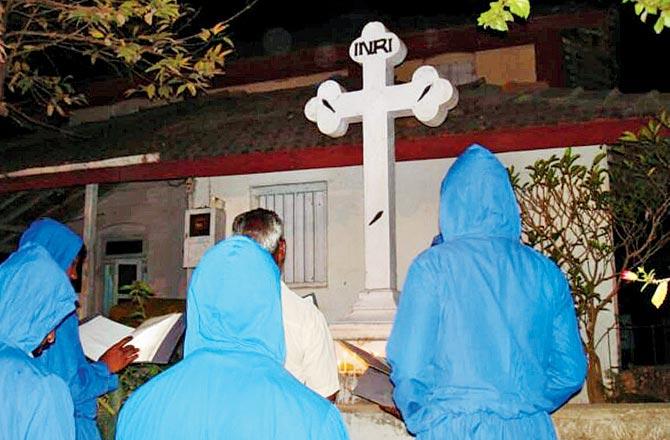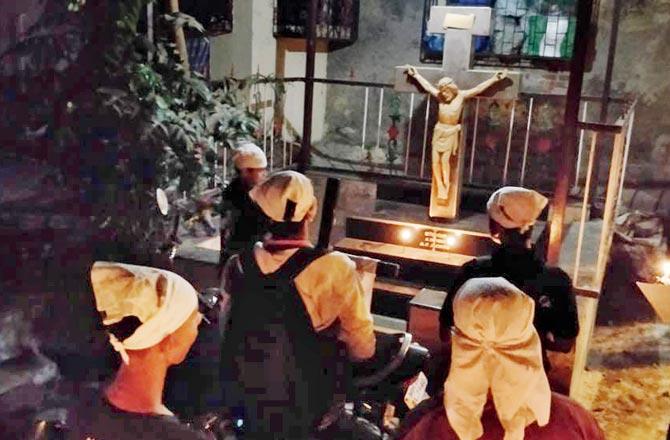Members of the Mobai Gaothan Panchayat are reviving papiya singing, an ancient East Indian Lenten tradition, that once encouraged Christians to pray in the dead of the night

Bryce Rodricks, 39, core member of the Mobai Gaothan Panchayat (MGP), has been assigned the Papiya Revival Project. Pic/Ashish Raje
As a child, Bryce Rodricks, 39, remembers the Lenten season—the 40-day period of fasting observed by Catholics—as sombre. Especially the time when his mother would wake him up in the dead of the night, to say: "The papiyas are here. Let us all pray." Their mournful chants in Marathi, accompanied by the haunting sound of a wooden clapper, imploring Christians to "wake up from their sleep, get down on their knees and pray and ask for God's forgiveness", would give Rodricks goosebumps. This was in the Bombay of the 1980s.
A few years later, after the 1992-1993 riots, the papiyas visits became less frequent. By the turn of the century, they had almost disappeared.

A papiya group at a gaothan. Pic/Walter Murzello
For the last four years, Rodricks, a taluka sarpach in Andheri, has been working with the Mobai Gaothan Panchayat (MGP), an organisation that represents the East Indian Community, to revive the ancient "reetin reevaj" of papiya singing—special prayers and hymns sung during Lent. The tradition is native to the local Christians of the city, and goes back several centuries. Papiyas—meaning penitent in Marathi—also known as devaats, comprised a group of 10 to 20 devout Christians, who moved about from cross to cross, singing late into the night. They became active from the Sunday night before Palm Sunday and wound up activity on Maundy Thursday. Papiyas would also move from one village to another while residents of the neighbourhood would keep a kettle of hot tea at the foot of the cross for the papiyas.
"They are said to be representatives of the apostles Peter, James and John who accompanied Jesus Christ to the Garden of Gethsemane, at the foot of Mount of Olives, where he prayed, before he was arrested and crucified," says Walter Murzello, founder trustee of MGP, instrumental in reviving the tradition. And so, papiyas shroud themselves in black, blue or brown tunics with a hood so they cannot be recognised. Gleason Barretto, also a founder trustee of MGP, says the legend goes that when papiya groups were very common, and would often cross paths, "the group that spotted the passing group would hide behind the bunds of the field till the other group passed."

Papiya groups wear shrouds and don't show their faces
At one point, every gaothan or parish boasted of its own papiya group, says Rodricks. "From over hundred papiya groups in the 1900s, we were reduced to two by 2004," he says. This was largely due to migration of community members to other countries and a declining interest in culture among the youth because jobs became the priority. The efforts of the MGP has upped the papiya groups to eight last year. "This year, we have 10," says Rodricks, who is part of the Papiya Group in Chakala, Andheri East. At present, there are papiya groups in Kurla, Kalina, Kharodi, Versova, Juhu, among others, while the goathans in and around Mumbai are 189.
Rodricks says their group is willing to visit any area where a local can guide them to 14 crosses. Each cross, represents one station of the cross. The group sings a hymn at every cross, followed by a prayer. "These crosses could be anywhere in the locality—someone's house, building or compound," he says. The visits are reserved for Saturday, begin at 11.30 pm and go on till five in the morning.
A member of the group usually does a recce a day prior, to mark the cross locations since they are not allowed to go back on the same path. "If they must, they have to go round and come out from another way," he says. Turning back leaves them susceptible to be "possessed by the evil".
All the hymns are sung in the native, East Indian dialect. Rodricks and the MGP team have been distributing leaflets of papiya hymns, some as old as the tradition itself, to groups interested in reviving it. The hymns talk about how Moses led the Jews out of slavery, to the coming of Jesus Christ, his good deeds, and having suffered for the sins of mankind. "Listening to the songs in the night can be a hair raising experience," says Barretto.
10
No. of papiya groups currently, up from 2 in 2004
Catch up on all the latest Crime, National, International and Hatke news here. Also download the new mid-day Android and iOS apps to get latest updates
 Subscribe today by clicking the link and stay updated with the latest news!" Click here!
Subscribe today by clicking the link and stay updated with the latest news!" Click here!









